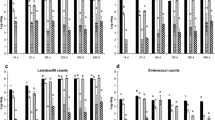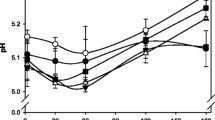Abstract
The ripening of industrial soft cheeses manufactured using a liquid pre-cheese produced from the ultrafiltration (UF) of milk was observed to be slow in comparison to that of cheese manufactured by a traditional process. Moreover, in the UF-cheeses investigated in this study, which were produced using Penicillium camemberti as the surface flora, several surface defects were observed: the texture was ‘carton’ like and the rind frequently detached from the cheese. To gain a fuller understanding of the development of these surface defects in UF-cheeses, the migration of different minerals and ions, and the study of the rind microstructure by scanning electron microscopy and X-ray mapping were performed. The results suggest that the slower diffusion of lactate, possibly due to the mineral layer at the surface of cheeses, acting as a barrier to its diffusion, may have caused an alteration in the metabolism and growth of the surface mould and may explain the surface defects of these UF-cheeses.
Abstract
(UF) Penicillium camemberti UF UF X UF
Résumé
Les fromages à pâte molle industriels produits par ultrafiltration (UF) à partir d’un pré-fromage liquide présentent un affinage retardé par rapport à des fromages produits à l’aide d’un procédé traditionnel. De plus, des fromages UF modèles produits avec seulement Penicillium camemberti comme flore de surface montrent une texture de carton et la croûte se détache souvent du fromage. La caractérisation des migrations des minéraux et des ions et l’étude de la microstructure de la croûte de ces fromages modèles par microscopie électronique à balayage et micro-analyse X ont été réalisées afin de comprendre l’origine de ces défauts. La diffusion retardée du lactate, peut-être due à la présence d’une couche minérale à la surface des fromages, pourrait être à l’origine de changements de métabolisme et de la croissance de la moisissure et pourrait expliquer la moindre qualité des fromages.
Similar content being viewed by others
References
Bech A.M., Characterising ripening in UF-cheese, Int. Dairy J. 3 (1993) 329–342.
Bouler J.M., Caractérisation et propriétés des orthophosphates de calcium, in: Gaucheron F. (Ed.), Minéraux et produits laitiers, Tec et Doc, Paris, France, 2004, pp. 25–54.
Brooker B.E., The crystallization of calcium phosphate at the surface of mould-ripened cheese, Food Microstr. 6 (1987) 25–33.
Brulé G., Maubois J.L., Fauquant J., Study of mineral salts in products obtained by milk ultrafiltration, Lait 54 (1974) 600–615.
Creamer L.K., Iyer M., Lelievre J., Effect of various levels of rennet addition on characteristics of Cheddar cheese made from ultrafiltered milk, N. Z. J. Dairy Sci. Technol. 22 (1987) 205–214.
De Koning P.J., De Boer R., Both P., Nooy P.F.C., Comparison of proteolysis in a lowfat semi-hard type of cheese manufactured by standard and by ultrafiltration techniques, Neth. Milk Dairy J. 35 (1981) 35–46.
Gaucheron F., Le Graët Y., Piot M., Boyaval E., Determination of anions of milk by ion chromatography, Lait 76 (1996) 433–443.
Goudédranche H., Utilisation du lysozyme en tant qu’agent régulateur de l’affinage en fromagerie MMV, Lait 66 (1986) 189–206.
Green M.L., Glover F.A., Scurlock E.M.W., Marshall R.J., Hatfield D.S., Effect of use of milk concentrated by ultrafiltration on the manufacture and ripening of cheddar cheese, J. Dairy Res. 48 (1981) 333–341.
Gripon J.C., Desmazeaud M.J., Le Bars D., Bergère J.L., Étude du rôle des microorganismes et des enzymes au cours de la maturation des fromages. II — Influence de la présure commerciale, Lait 55 (1975) 502–516.
Hannon J.A., Deutsch S.M., Madec M.N., Gassi J.Y., Chapot-Chartier M.P., Lortal S., Lysis of starters in UF cheeses: behaviour of mesophilic lactococci and thermophilic lactobacilli, Int. Dairy J. 16 (2006) 324–334.
Hannon J.A., Lopez C., Madec M.N., Lortal S., Altering renneting pH changes microstructure, cell distribution and lysis of Lactococcus lactis AM2 in cheese made from ultrafiltered milk, J. Dairy Sci. 89 (2006) 812–823.
Harper J., Iyer M., Knighton D., Lelievre J., Effects of whey proteins on the proteolysis of cheddar cheese slurries (a model for the maturation of cheeses made from ultrafiltered milk), J. Dairy Sci. 72 (1989) 333–341.
Hickey M.W., van Leewen H., Hillier A.J., Jago G.R., Amino acid accumulation in Cheddar cheese manufactured from normal and ultrafiltered milk, Aust. J. Dairy Technol. 38 (1983) 110–113.
International Dairy Federation, Milk — determination of nitrogen content — Part 2: blockdigestion method (macro method), IDF 20-2, ISO 8968-2, Int. Dairy Fed., Brussels, Belgium, 2001, pp. 1–10.
Karahadian C., Linsay R.C., Integrated roles of lactate, ammonia, and calcium in texture development of mold surface-ripened cheese, J. Dairy Sci. 70 (1987) 909–918.
Lawrence R.C., The use of ultrafiltration technology in cheesemaking, Bull. Int. Dairy Fed. 240 (1989) 1–15.
Le Graët Y., Brulé G., Migration des macro et oligo-éléments dans un fromage à pâte molle de type Camembert, Lait 68 (1988) 219–234.
Le Graët Y., Lepienne A., Brulé G., Ducruet P., Migration du calcium et des phosphates inorganiques dans les fromages à pâte molle de type camembert au cours de l’affinage, Lait 63 (1983) 317–332.
Leclercq-Perlat M.N., Buono F., Lambert D., Latrille E., Spinnler H.E., Corrieu G., Controlled production of Camembert-type cheeses. Part I: Microbiological and physicochemical evolutions, J. Dairy Res. 71 (2004) 346–354.
Lenoir J., L’activité protéasique dans les fromages à pâte molle de type camembert, Rev. Lait. Fr. 275 (1970) 231–243.
Lenoir J., Les flores de surface et leur rôle au cours de l’affinage des fromages, Bull. Int. Dairy Fed. 171 (1984) 3–19.
Mistry V.V., Maubois J.L., Application of membrane separation technology to cheese production, in: Fox P.F. (Ed.), Cheese Chemistry, Physics and Microbiology, Chapman & Hall, London, UK, 1993, pp. 493–522.
Pommert J.F., Klaebe A., Perie J., Lebugle A., Puech J., Observation and analysis of crystalline phases in processed cheese, J. Food Sci. 53 (1988) 1367–1447.
Saboya L.V., Goudédranche H., Maubois J.L., Lerayer A.L.S., Lortal S., Impact of broken cells of lactococci or propionibacteria on the ripening of Saint-Paulin UF-cheeses: extent of proteolysis and GC-MS profiles, Lait 81 (2001) 699–713.
Saboya L.V., Lortal S., Lerayer A.L.S., Maubois J.L., Absence of lactococcus lysis in ultrafiltered cheeses, in: 23rd IDF World Dairy Congress, Congrilait, 24–27 September 2002, Paris, 2002.
Schlesser J.E., Schmidt S.J., Speckman R., Characterization of chemical and physical changes in Camembert cheese during ripening, J. Dairy Sci. 75 (1992) 1753–1760.
Author information
Authors and Affiliations
Corresponding author
About this article
Cite this article
Hannon, J.A., Lortal, S., Tissier, JP. et al. Limited ripening of low-fat UF-cheese due to CaPO4 barrier?. Dairy Sci. Technol. 89, 555–568 (2009). https://doi.org/10.1051/dst/2009035
Received:
Revised:
Accepted:
Issue Date:
DOI: https://doi.org/10.1051/dst/2009035




